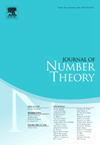关于Birch-Erdős和m个分区定理的注意事项
IF 0.7
3区 数学
Q3 MATHEMATICS
引用次数: 0
摘要
设p,q>;1为两个相对素数,N为非负整数的集合。设fp,q(n)是n的不同表达式的个数,表示为{pαqβ:α,β∈n}中不同项的和。Erdős推测,然后Birch证明,只要n足够大,fp,q(n)≥1。在本文中,对于所有足够大的数n,我们证明了q(n)=2(log (n))22log (plg)) q(1+O(log (log)) /log (n))。我们还证明了limn→∞(f2,q(n+1)/f2,q(n)=1。此外,我们将指出f2,q(n)和m-ary分区之间的关系。本文章由计算机程序翻译,如有差异,请以英文原文为准。
Note on a theorem of Birch–Erdős and m-ary partitions
Let be two relatively prime integers and the set of nonnegative integers. Let be the number of different expressions of n written as a sum of distinct terms taken from . Erdős conjectured and then Birch proved that provided that n is sufficiently large. In this note, for all sufficiently large number n we prove We also show that . Additionally, we will point out the relations between and m-ary partitions.
求助全文
通过发布文献求助,成功后即可免费获取论文全文。
去求助
来源期刊

Journal of Number Theory
数学-数学
CiteScore
1.30
自引率
14.30%
发文量
122
审稿时长
16 weeks
期刊介绍:
The Journal of Number Theory (JNT) features selected research articles that represent the broad spectrum of interest in contemporary number theory and allied areas. A valuable resource for mathematicians, the journal provides an international forum for the publication of original research in this field.
The Journal of Number Theory is encouraging submissions of quality, long articles where most or all of the technical details are included. The journal now considers and welcomes also papers in Computational Number Theory.
Starting in May 2019, JNT will have a new format with 3 sections:
JNT Prime targets (possibly very long with complete proofs) high impact papers. Articles published in this section will be granted 1 year promotional open access.
JNT General Section is for shorter papers. We particularly encourage submission from junior researchers. Every attempt will be made to expedite the review process for such submissions.
Computational JNT . This section aims to provide a forum to disseminate contributions which make significant use of computer calculations to derive novel number theoretic results. There will be an online repository where supplementary codes and data can be stored.
 求助内容:
求助内容: 应助结果提醒方式:
应助结果提醒方式:


